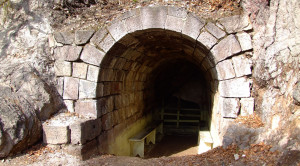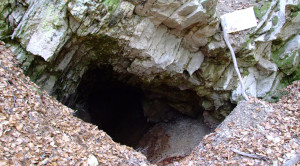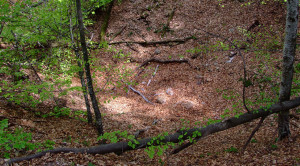Last week, I talked about bold explorer Charles Boner and his dreadful journey to Büdös. What, you might ask, possessed him to make such a terrible and uncomfortable trip through wolf-haunted forests? Well, it was to visit the CAVE OF DEATH!!!
For his health.
The area around Büdös Mountain (916m), near Turai in Covasna County, is replete with sulphurous vents. Indeed, in Hungarian ‘Büdös’ means ‘stinking’. Many gas vents bubble up through waters, and these sulphur baths were very popular as a curative in the Victorian age and before. In other places, and with little sign, these gasses leak through the ground. Sulphur mining was prevalent, if primitive – many of the mines were abandoned, some at a very early stage, when the gasses built to lethal levels. More on that in a moment.
At the time Boner visited in the 1860’s, as was typical of the time, there were few permanent facilities constructed to take advantage of these natural resources.
“In summer-time there are always people here who seek relief for their ailing. But as the place is in the middle of a forest, with no habitation near, those who come must build their own dwelling, as well as bring with them wherewithal to supply their necessities. I saw the remains of such abodes. Fragile as they are, however, the winter storms soon sweep away every vestige of them. They are mere huts, built of fir-branches, cunningly entwined. The Wallacks are extremely skilful in constructing them. When out shooting, I have been surprised at the quickness with which they are built. Hardly had we arrived at the place of our encampment, when the hatchets resounded in the wood, and one tall young fir after another was seen toppling over to the ground. On returning, some hours after, a large hut was erected for me; on one side, a bed of dry leaves, covered with green fragrant twigs, and in the middle a large fire of resinous pine logs blazed cheerfully.”
Wealthier people did not have to endure such privations when visiting the springs. Some of them, such as the Austrian general and his family of whom Boner was told, could afford to have small houses made of boards or even stone, but even these were left to succumb to rot and ruin. Regardless of the wealth of the visitor, supplies could be brought up from the nearby villages of Büksad or Torja (Turia). Charles also found a gravestone, marking the burial of someone whose quest for better health went badly wrong. This brings us to the other ‘attraction’ the area around Mt. Büdös offered.
Boner was taken to two already well known caves in the rock:
“The phenomena which make it (the mountain) remarkable are two cave-like clefts in the whitish-grey calcined trachyte rock, whence, by innumerable fissures, sulphuretted hydrogen gas streams forth, mixed with carbonic acid. The walls are covered with sublimate of sulphur, formed by the gases coming in contact with the colder air.

The ‘Stinking Cave’ as it is now. (Picture from http://www.budoshegy.ro/en/utovulkani-mukodesek.php)
“The one cavern – though it hardly deserves the name – recedes about twenty steps. In order to enter it with safety, care must be taken not to draw breath while in the fatal place. A long respiration is made before rushing in, the nostrils are closed, and then, with hasty steps, the further extremity is reached. A prickling feeling in the eyes is caused by the warm atmosphere. From the feet upwards, the whole body has the agreeable sensation of gentle heat playing around every limb. But your stock of breath is exhausted, and you run back again to the open air, where to breathe does not bring death. The day before I was there a man had committed suicide by entering a step or two. He dropped at once; and when a shepherd that was tending his flocks on the opposite hillside, and who saw him enter, came across to look for him he was dead. The vapours of this cave are highly valued, as a cure for gout, and for diseases of the eye.”
It was not necessary for a visitor to enter the ‘Cave of Death’ to feel the unfortunate effects of the vapours.
“Not far from this cleft is a second, called Gyilkos – the Murderer. In flying past the opening, birds drop dead upon the ground. Close to the entrance I found a jay that had thus met death.”
In the 1830’s, the same area was visited by John Paget. In his book “Hungary and Transylvania; with remarks on their condition, social, political, and economical” (1839), he remarked that the ‘Gyilkoslyuk’ or ‘Murder-hole’ was still in use, mainly by the local peasants (though there were annual deaths, leading to the name). It had been larger a couple of years before his visit, but an earthquake had brought some of it down. The locals had a cunning, if clearly rather unreliable, method of ascertaining how far it was safe to go into the cave “…by striking their flints, and stopping when they no longer give sparks.” Visitors could walk in until the heavy gas reached their chins, then spend an hour enjoying the prickling sensations. Clearly, between Paget’s visit and Boner’s, some 30 years later, the cave – in fact an ancient sulphur mine – filled entirely with gas to the point that where it wafted out from the cave mouth it was still concentrated enough to kill.
This is not the only place that is fatal for wildlife. The ‘Bird’s Cemetary’ is a 3m deep, 15m wide depression in the nearby woods. Filled to the brim with instantly lethal gas it shows no visible signs of this, save perhaps for the bones of any creature that ventures through.
Still, at least they won’t have gout anymore.
References:
Transylvania; It’s Products and its People (Boner, 1865), pages 307 onwards





